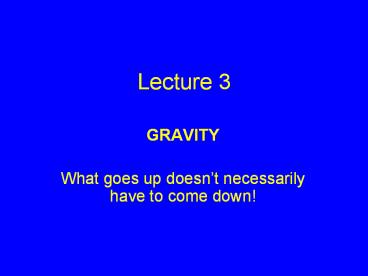GRAVITY - PowerPoint PPT Presentation
1 / 18
Title: GRAVITY
1
Lecture 3
- GRAVITY
- What goes up doesnt necessarily have to come
down!
2
Review laws of motion
- ? No force is required to keep an object moving
with constant velocity. - What can change the velocity of an object ?
? FORCES - for example
- friction or air resistance
- GRAVITY
3
Weight and gravity
- All objects exert an attractive force on each
other Universal Law of Gravity - Your weight is the attractive force that the
earth exerts on you- its what makes things fall! - All objects are pulled toward the center of the
earth by gravity. - The suns gravity is what holds the solar system
together.
4
The sun is the most massive object in the solar
system, about 3 million times the earths mass
and 1000 times more massive than the most
massive planet-Jupiter
5
A little Astronomy
- The planets revolve around the sun in
approximately circular paths (Kepler) - The further the planet is from the sun the longer
it takes to go around (Kepler) - The time to go around the sun is a year
- the earth spins on its axis once every day
the moon revolves around the earth
once every month
6
What does your weight depend on?
- The weight w of an object depends on its mass and
the local strength of gravity- we call this g
the acceleration due to gravity - Weight points toward the earths center
- Sometimes down is up!
7
What is this thing called g?
- g is something you often hear about, for example
- You might hear that a fighter pilot experienced
so many gs when turning his jet plane. - ? g is the acceleration due to gravity.
- When an object falls its speed increases as it
decends - acceleration is the rate of change of velocity
- g is the amount by which the speed of a falling
object increases each second about 10 m/s each
second (9.8 m/s/s to be exact)
8
Example a falling object
time velocity
0 s 0 m/s
1 s 10 m/s
2 s 20 m/s
3 s 30 m/s
4 s 40 m/s
5 s 50 m/s
9
How to calculate weight
- Weight mass x acceleration due to gravity
- Or w m x g (mass times g)
- In this formula m is given in kilograms (kg) and
g ? 10 meters per second per second (m/s2), then
w comes out in force units Newtons (N)
10
example
- What is the weight of a 100 kg object?
- w m x g 100 kg x 10 m/s2 1000 N
- _______________________________
- One Newton is equal to 0.225 lb, so in these
common units 1000 N 225 lb - Often weights are given by the equivalent mass in
kilograms, we would say that a 225 lb man
weighs 100 kg.
11
You weigh more on Jupiter and less on the moon
- The value of g depends on where you are, since it
depends on the mass of the planet - On the moon g ? 1.6 m/s2 ? (1/6) g on earth, so
your weight on the moon is only (1/6) your weight
on earth - On Jupiter g ? 23 m/s2 ? 2.3 g on earth, so on
Jupiter you weigh 2.3 times what you weigh on
earth.
12
Get on the scaleHow to weigh yourself
13
Free Fall
- Galileo showed that all objects (regardless of
mass) fall to earth with the same acceleration ?
g 10 m/s2 - This is only true if we remove the effects of air
resistance. demos - We can show this by dropping two very different
objects inside a chamber that has the air
removed.
14
Galileos experiments
- To test this we must drop two objects from the
same height and measure the time they take to
fall. - If H isnt too big, then the effects of air
resistance are minimized
H
15
On the other hand . . .
- If you drop an object from a small height it
falls so quickly that it is difficult to make an
accurate measurement of the time - We can show experimentally that it takes less
than half a second for a mass to fall 1 meter.
(demo) - How did Galileo deal with this?
16
Galileo made g smaller!
h
h
D
D
17
What did Galileo learn from theinclined plane
experiments?
- He measured the time it took for different masses
to fall down the inclined plane. - He found that different masses take the same time
to fall down the inclined plane. - Since they all fall the same distance, he
concluded that their accelerations must also be
the same. - By using different distances he was able to
discover the relation between time and distance.
18
How did Galileo measure the time?
- Galileo either used his own pulse as a clock (he
was trained to be a physician) - Or, a pendulum.































